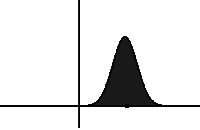福克-普朗克方程式
福克-普朗克方程式(Fokker–Planck equation)描述粒子在位能場中受到隨機力後,隨時間演化的位置或是速度的分佈函數 [1] 。此方程式以荷蘭物理學家阿德里安·福克[2]與馬克斯·普朗克[3]的姓氏來命名。

一維 x方向上,福克-普朗克方程式有兩個參數,一是拖曳參數 D1(x,t),另一是擴散 D2(x,t)
在 維空間中的福克-普朗克方程式是
其他
編輯
若V=0,則福克-普朗克方程式成為布朗運動
與隨機方程式的關係
編輯福克-普朗克方程式可以用來計算隨機過程裏隨機微分方程式中分佈函數的解。
一個受隨機力的經典粒子,經由朗之萬方程式可以得到福克-普朗克方程式。另外再藉由福克-普朗克方程式也可推導薛定諤方程式[4]。
參考資料
編輯- ^ Leo P. Kadanoff. Statistical Physics: statics, dynamics and renormalization. World Scientific. 2000. ISBN 9810237642.
- ^ A. D. Fokker, Die mittlere Energie rotierender elektrischer Dipole im Strahlungsfeld, Ann. Phys. 348 (4. Folge 43), 810–820 (1914).
- ^ M. Planck, Sitz.ber. Preuß. Akad. (1917).
- ^ Edward Nelson ,"Derivation of the Schrödinger Equation from Newtonian Mechanics",Phys. Rev. 150, 1079–1085 (1966)
相關條目
編輯延伸閱讀
編輯- Hannes Risken, "The Fokker–Planck equation : Methods of Solutions and Applications", 2nd edition, Springer Series in Synergetics, Springer, ISBN 3-540-61530-X.
- David Tong. Kinetic Theory. Ch. 3. https://www.damtp.cam.ac.uk/user/tong/kinetic.html (頁面存檔備份,存於互聯網檔案館)
- Scott. Applied Stochastic Processes.
![{\displaystyle {\frac {\partial }{\partial t}}f(x,t)=-{\frac {\partial }{\partial x}}\left[D_{1}(x,t)f(x,t)\right]+{\frac {\partial ^{2}}{\partial x^{2}}}\left[D_{2}(x,t)f(x,t)\right].}](https://wikimedia.org/api/rest_v1/media/math/render/svg/a851f9f8af87ef864a937f4fd0eae85f750c549b)

![{\displaystyle {\frac {\partial f}{\partial t}}=-\sum _{i=1}^{N}{\frac {\partial }{\partial x_{i}}}\left[D_{i}^{1}(x_{1},\ldots ,x_{N})f\right]+\sum _{i=1}^{N}\sum _{j=1}^{N}{\frac {\partial ^{2}}{\partial x_{i}\,\partial x_{j}}}\left[D_{ij}^{2}(x_{1},\ldots ,x_{N})f\right],}](https://wikimedia.org/api/rest_v1/media/math/render/svg/619522eefdacb8073c9d778fe21d3bd0c0285fe0)



